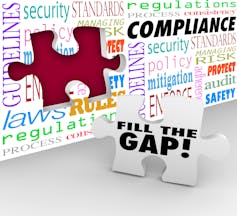How donors can help make nonprofits more accountable
Digital innovations are making it easier to give to charity and for donors to become informed before they support nonprofits.

As the devastating 2017 hurricane season got underway, the Internal Revenue Service warned Americans to watch out for scammers asking for donations to nonexistent charities.
But, especially as fundraising pitches pile up in their inboxes and mailboxes during the final months of the year, donors need to do more than avoid fake nonprofits, because contributions to seemingly legitimate charities can also be a waste of money.
A good example is Project Cure. The Florida-based nonprofit was spending little of the millions it had raised on its official mission – lobbying Congress about alternative treatments for cancer, diabetes and Alzheimer’s disease – when it got the dubious distinction of making the “America’s Worst Charities” list compiled by the Tampa Bay Times and the Center for Investigative Reporting and published in their 2013 expose.
What’s perhaps even more troubling is that donors can continue to give to these unworthy causes after their outrages come to light. Project Cure, which is not affiliated with similarly named groups in Colorado and Ohio, still drew more than US$5.5 million in donations in 2015, two years after becoming known as a textbook example of a bad charity, according to the most recent information available. According to IRS records, it continues to operate.
Donor beware
As political scientists who do extensive research on nonprofits, we would like to see more donors look into the charities they support. Since Americans tend to grow more generous as the year winds down, making more than 20 percent of their online charitable donations in December, this is an ideal season for donors to step up their scrutiny.
On average, the charities that made the “50 Worst” list were channeling less than 4 percent of the money they raised into work tied to their missions in 2013. More donor scrutiny would, we believe, cut down on this kind of opportunism that takes place, in part, because official crackdowns are rare.
One exception came in 2015. That’s when every state attorney general joined the Federal Trade Commission, an agency charged with monitoring and protecting consumers from anti-competitive, deceptive or unfair business practices, in disciplining four cancer charities operating as runaway gravy trains.
The agency probed James Reynolds Sr., his ex-wife Rose Perkins, his son James Reynolds Jr. and business associate Kyle Effler. The four of them managed the Cancer Fund of America, Cancer Support Services, the Children’s Cancer Fund of America and the Breast Cancer Society – charities the FTC said squandered $187 million in donations.
Instead of using the money to help people with cancer, the funds paid for fancy cars and trips, cruises, college tuition and other personal benefits like memberships to gyms and dating sites, along with exorbitant salaries for the friends and relatives of the nonprofits’ leaders.
Eventually, all four reached settlements in which they agreed to stop doing charity work and pay steep fines.
Presumed good intentions
Unfortunately, not enough U.S. donors do any research about the nonprofits they’re supporting before clicking that “donate” button. According to a 2011 study – the most recent research available – fewer than one in four donors review information published by charity watchdogs before making donations.
We believe this lack of due diligence, despite the evidence that many charities aren’t trustworthy, reflects a widespread presumption that nonprofits and the people who run them toil selflessly for the public good.
This faith makes some sense, especially in contrast with the private sector. The legal obligation to maximize benefits for shareholders – like earning big profits – may cause companies to do things that damage the environment or harm society.
Nonprofits, in contrast, can’t legally distribute any profits they earn to the people who support them financially.
Underwhelming oversight
Partly due to this notion of nonprofit virtue, the government and donors conduct little formal oversight of nonprofits. That creates opportunities for people who abuse this trust.
Besides their apparent trustworthiness, nonprofits are vulnerable to waste, fraud and abuse because it’s easy to establish and run them as long as the IRS determines that they are legitimate.
New charities spending less than $50,000 a year are currently eligible for automatic tax-exempt status that the IRS may rescind later.
Nonprofits are required, however, to report once a year to the IRS about their finances, including what they pay their highest-paid staff. This information is in the public domain. Since 2016, locating this information has been as easy as searching the internet for a group’s 990 form.
Furthermore, states establish their own regulations and have enforcement authority over charities operating within their own borders. State attorneys general, for example, can investigate and sue over infractions. However, the extent of this oversight varies widely, according to a study conducted by the Charities Regulation and Oversight Project at Columbia Law School and the Center on Nonprofits and Philanthropy at the Urban Institute.
Dedicated staffing is limited in most states – few employ more than 10 people to administer and enforce charity laws and regulations.

The Federal Trade Commission can always start a probe or lawsuit against a charity that it deems to be involved in fraudulent activities, as can state attorneys general. But such FTC actions are rare.
Finding information
Given the gaps in official oversight, individual donors have an important role to play in preventing nonprofit waste, fraud and abuse.
One way donors can do their share is to seek out independent sources of important information about how well nonprofits are spending their money. Watchdogs such as Charity Navigator, which evaluate and rate nonprofit performance, are good sources to consult before making donations.
In addition, private certification systems are emerging. For example, the Better Business Bureau’s Wise Giving Alliance has established a charity accreditation system.
The good news is that many nonprofits are welcoming this unofficial external scrutiny. These groups find that telegraphing to donors that they are willing to voluntarily take steps to prevent fraud and waste serves their own interests.
Irresponsible or even fraudulent charities, after all, are unlikely to do this.
GoFundMe, a platform for personal online fundraising, can also help donors find and support legitimate charities. For example, it hosts a page created by Clark County Commission Chairman Steve Sisolak and Sheriff Joe Lombardo to assist survivors of the recent mass shooting in Las Vegas and relatives of the people who died.
The page, which went live on Oct. 2, had raised more than $11 million by Halloween. Attorney Kenneth Fienberg, who administered compensation for victims of the 9/11 terrorist attacks, will help the county figure out how to distribute the money.
Whether donors give directly to nonprofits online or by other means, including mobile giving apps, they can use these seals of approval to recognize which charities deserve a hand during fall and holiday-season fundraising campaigns – or any other time of the year.
Aseem Prakash serves on the National Academies of Sciences, Engineering, and Medicine's Board on Environmental Change and Society and is a member of Economic Development Commission of the city of Edmonds.
Nives Dolsak serves on the Science Panel of the Puget Sound Partnership.
Read These Next
Supreme Court case about ‘crisis pregnancy centers’ highlights debate over truthful advertising stan
There are some 2,500 of these centers across the United States. Many are located within a mile of an…
How rogue nations are capitalizing on gaps in crypto regulation to finance weapons programs
North Korea was behind a $1.5 billion digital bank heist in February 2025. Other countries are similarly…
My prescription costs what?! Pharmacists offer tips that could reduce your out-of-pocket drug costs
High prescription drug costs are leaving many patients frustrated and unable to afford their medications.





